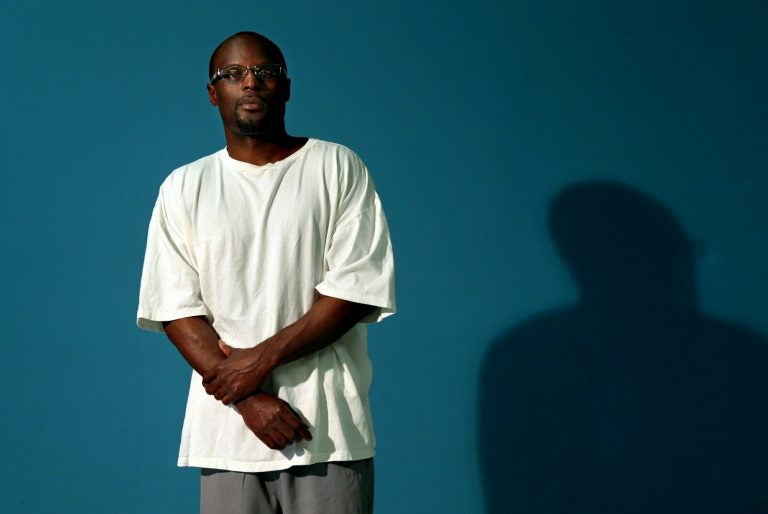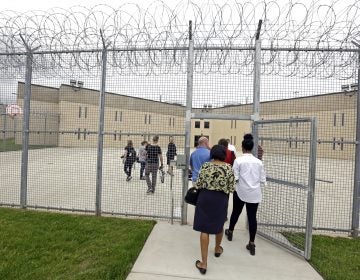After 2016 ruling, battles over juvenile lifer cases persist
About 400 offenders originally sentenced to life without parole as juveniles have been released nationwide, and hundreds of others have been resentenced to shorter terms.

In this Thursday, July 10, 2014 photo, Bobby Bostic stands for a portrait in the visitation room at the Crossroads Correctional Center in Cameron, Mo., where he has served 23 years of a 241-year sentence for a 1995 robbery. At the age of 16, Bostic and a friend held up some people delivering some donated Christmas gifts to a needy St. Louis family. Bostic fired a shot that grazed one man. (Robert Cohen/St. Louis Post-Dispatch via AP)
Locked up for life at 15, Norman Brown remains defined by the crime that put him behind bars.
Twenty-seven years ago, Brown joined a neighbor more than twice his age to rob a jewelry shop in Chesterfield, Missouri, and the man shot the owner to death. The shooter was executed. But state officials, bound by a 2016 U.S. Supreme Court ruling, pledged to give Brown an opportunity to get out — then rejected parole in a process a federal judge ruled recently must be overhauled.
Three years after the Supreme Court gave inmates like Brown a chance at freedom, the justice system is gaining speed in revisiting scores of cases. About 400 offenders originally sentenced to life without parole as juveniles have been released nationwide, and hundreds of others have been resentenced to shorter terms or made eligible for release by law.
But most remain behind bars as prosecutors and judges wrestle with difficult cases. Tensions have mounted and lawsuits have been filed in states like Missouri, while in 21 others, life-without-parole sentences are prohibited for those 17 and younger. About a third of those bans have been approved since 2016, according to the Campaign for the Fair Sentencing of Youth.
“The national trend is certainly one where states are moving away from these sentences, whether by legislation or through the courts,” said Jody Kent Lavy, executive director of the group. But “there are still some outliers that in many ways are refusing to comply with the court’s mandate.”
In Missouri, lawmakers decided the more than 100 inmates serving life for adolescent crimes would get a parole hearing after 25 years. But the state is in court because the parole board has denied release in 85 percent of cases it has heard and has yet to free anyone.
Parole hearings have been brief and focused on inmates’ crimes, with little, if any, attention on the circumstances preceding them or what offenders have done to rehabilitate themselves, a lawsuit filed by the MacArthur Justice Center alleges.
The board’s actions violate the constitutional requirement that inmates be provided a “realistic opportunity for release,” a federal judge found in October, ordering changes. Missouri’s corrections agency and attorney general’s office declined comment.
After Brown’s hearing in May 2017, the board cited his crime in denying parole. The state has since argued he is not yet eligible because he received consecutive sentences. Brown, now 42, said he hopes the board will eventually recognize his remorse, as well as his thousands of hours in restorative justice programs and work as a prison hospice caretaker and training rescue dogs.
In a telephone interview from Potosi Correctional Center, Brown recounted what he did that night in 1991.
“It’s shameful. … Because I’m an adult now, I know what it is to love your family,” he said. “I can definitely see where (opposition to release) comes from, and I think it comes from a place of pain.”
Florence Honickman’s husband, Stephen, was killed by Brown’s companion, and she vividly recalls the teen snatching a pendant off her neck as she lay bleeding from bullet wounds. She lives in Florida but returned to Missouri to oppose Brown’s parole.
“My family was turned upside down and inside out,” she said in an interview. “Do you really know deep down that this man — he’s a man now, not a child — has he really, really changed?”
The high court’s 2016 decision, one of four in recent years focused on the punishment of juveniles, hinged partly on research showing the brains of adolescents are slow to develop, making teen offenders likelier to act recklessly but capable of rehabilitation. The court said they must not be punished with the same severity and finality as adults, and that a life-without-parole sentence should be reserved for those inmates deemed beyond rehabilitation.
At the time, more than 2,000 inmates were serving mandatory life-without-parole sentences, most for murder convictions. And most cases were clustered in a few states.
In Pennsylvania, 399 of more than 500 juvenile lifers have been resentenced and 163 have been released, according to the Department of Corrections. Bradley Bridge, of the Defenders Association of Philadelphia, said the last of that city’s 325 lifers could be resentenced this spring. Judges have recently rejected some negotiated sentences as too light. The last of their deliberations are complicated by the fact that many still awaiting resentencing have served less time and have less of a prison record to assess, or they have mental illnesses or a history of prison violations.
“The cases we have remaining are probably the toughest ones,” Bridge said.
In Louisiana, after years of resistance by courts and prosecutors, the state is reconsidering the sentences of roughly 300 offenders. Through December, 45 had come before a parole committee, with 37 approved for release and 31 of those now out, according to the Board of Pardons and Parole.
Ivy Mathis was released in December after serving 26 years for killing a man during a home robbery. Mathis said that in prison she outgrew the rebelliousness of her teen years, worked in hospice care and got culinary training. She now works as a cook in two restaurants.
“I’m just thanking God, and I made up my mind, I will never return to prison. … I’m not taking this second chance for granted,” she said.

Henry Montgomery, whose case was at the center of the Supreme Court’s 2016 ruling, has not been so lucky. Montgomery, 72, was denied parole last year. He was 16 when he killed a police officer who caught him skipping school. Montgomery, who worked in a prison silk screening shop and founded a boxing association for inmates, will be eligible for another hearing in February 2020.
“He’s stoic,” said Keith Nordyke, a lawyer with the Louisiana Parole Project. “You know one of the things that prison teaches you — 54 years of prison — is patience.”
Louisiana prosecutors are seeking new life sentences for 80 other inmates; the state recently approved $1.3 million for inmates’ defense.
In Michigan, where a case before the state Supreme Court delayed reconsideration of many cases, more than 140 inmates have been resentenced, and about half of them have been freed. But prosecutors are pursuing new life-without-parole sentences for about 200 others.
Kent County Prosecutor Chris Becker has sought no-parole terms in about half of his 24 cases, and judges so far have agreed for four inmates — including Damon Jackson, 39, convicted in the death of his infant son. The boy was shaken, sexually abused and left blind and deaf before dying 2½ years later.
“We tried to take the worst of the worst, the most depraved ones,” Becker said.
In some cases, judges have rebuffed prosecutors’ bids for new life terms.
In another Kent County case, a judge recently resentenced inmates Chad Maleski and Joshua Rogers to 35 to 60 years, making them parole-eligible in about 17 years. Maleski and Rogers were 17 when they joined two others in abducting 66-year-old Willie Jones outside a Grand Rapids bowling alley. Jones was stuffed in the trunk of his car, repeatedly stabbed and left to die in a field. The judge cited Rogers’ remorse and participation in prison self-improvement programs and Maleski’s cooperation that led authorities to Jones’ body. Both men apologized.
James Jones, the victim’s nephew, had planned to speak harshly about Rogers at his resentencing. But after praying and hearing of the inmate’s progress, he offered forgiveness.
“Who knows what God has (in store) for this young man?” Jones said.
While the Supreme Court’s decision has prompted change, the justices have shown little appetite for revisiting the issue of juvenile sentences, leaving unsettled what to do with the thousands of other former teen offenders who are legally entitled to parole but serving such lengthy terms they are unlikely to ever get out.
In April, the court declined to hear the case of Missouri offender Bobby Bostic, who was 16 when he and a friend held up people delivering donated Christmas gifts to a poor St. Louis family. Bostic fired a shot that grazed one man. The teens also forced their way into a woman’s car and demanded cash at gunpoint. Bostic’s friend groped the victim before the two teens released her.
Bostic, who turned down a plea bargain, was sentenced to 241 years and won’t be eligible for parole until he turns 112. He unsuccessfully appealed his sentence to Missouri’s top court. And despite an earlier ruling banning life sentences for juveniles who did not kill, the high court declined to take the case.
“I’m not the victim,” said Bostic, 40, who dreams of publishing six nonfiction books and nine volumes of poetry if released. “But a teenager dying in prison, what lesson do you teach him? He’s got nothing to hope for.”
In Maryland, the American Civil Liberties Union alleges in a lawsuit the state’s parole system is unconstitutional because the release of juvenile offenders is rare and decided in secrecy. When the case was filed in 2016, no juvenile offender had been paroled for nonmedical reasons in two decades, said Sonia Kumar, an ACLU lawyer.
State law requires the governor to approve parole for any inmates sentenced to life. Gov. Larry Hogan has granted parole to three former juvenile offenders since taking office in 2015, all for medical reasons, and has granted clemency to two others.
Kumar argues there still is no meaningful opportunity for the state’s 200-300 juvenile lifers to get out, even if they have evidence of rehabilitation. She represents two inmates recommended for clemency in 2017 whose cases are still pending with the governor. Both have served more than 35 years, have almost perfect prison records and have taken education classes, held jobs and won praise from corrections officers. Hogan’s spokeswoman said these decisions require a “thorough deliberative process.”
Other governors have recently approved inmates’ release.

Before exiting office, Tennessee Gov. Bill Haslam granted clemency this month to Cyntoia Brown, who was 16 when she got life for fatally shooting a Nashville real estate agent after he picked her up and paid her for sex. Brown’s lawyers contended she was a sex trafficking victim who not only feared for her life but also lacked the mental capability to be culpable in the slaying because she was impaired by her mother’s alcohol use while she was in the womb.
Under Tennessee’s sentencing laws, Brown, now 30, would not have been eligible for parole until after serving 51 years — a mandate the governor said was “too harsh, especially in light of the extraordinary steps Ms. Brown has taken to rebuild her life.”
Colorado Gov. John Hickenlooper granted clemency last month to Curtis Brooks, serving life for his role in a 1995 fatal carjacking at the age of 15. Brooks already has served about 24 years; if he’d been resentenced per the Supreme Court’s ruling, he would have faced at least six more before becoming eligible for parole.

Brooks was homeless when he met three boys and joined in a plan to steal a car in exchange for a place to stay, according to his former public defender, Hollynd Hoskins, who shepherded his clemency petition. Christopher Ramos, 24, was killed in the carjacking; Brooks was not the shooter.
Brooks’ release was championed by a juror who convicted him, the trial judge, the lead detective in the case and his former elementary school teacher, now a Maryland legislator. He plans to work for her after his release in July. The victim’s family had opposed clemency, however, and Brooks said he would not presume to ask for their forgiveness.
“It’s not that I don’t want it. I don’t know if I am deserving,” he said in a phone interview from prison. “I want them to see in the way I live my life that I do understand the impact of what happened that night. … I want them hopefully one day to see the person I was, not the person I am.”
WHYY is your source for fact-based, in-depth journalism and information. As a nonprofit organization, we rely on financial support from readers like you. Please give today.




